|
|
|
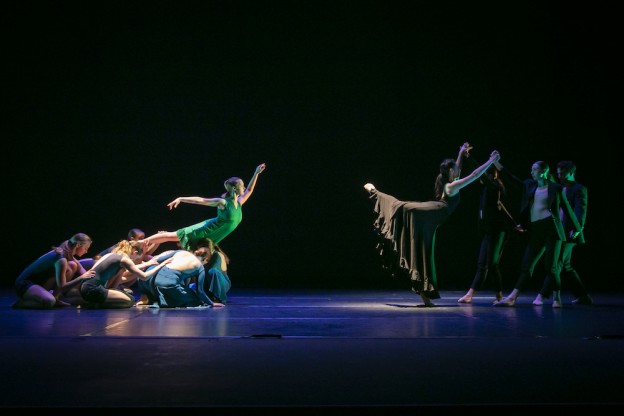
|
|
|

On April 8th, Megan Race, a postdoctoral fellow at Harvard’s Davis Center for Russian and Eurasian Studies, came to speak to Swarthmore students and faculty in a lecture on George Balanchine’s 1962 tour of the Soviet Union. Combining her academic research in Slavic Languages and Literatures with a long-established love for dance, Race has been working on a project that explores the Soviet media reception and depiction of the New York City Ballet. And throughout her lecture, she focused particularly on how Balanchine’s “modernist” ballets were received in the Soviet Union, a place where the government had laid out socialist realism expectations for the arts since the 1930s.
Professor Olivia Sabee of the Swarthmore Dance Program first met Megan Race when both were completing their undergraduate degrees at the University of Chicago.
“I met Megan about fifteen years ago when we danced in a production of Le Corsaire together. Though we didn’t know it at the time, those experiences staging (we both also set portions of this ballet and Cinderella on other dancers) would be formative in realizing how work in the studio might intersect with academic research,” Sabee reminisced.
A few years ago, Race’s and Sabee’s paths crossed again when they met at the American Comparative Literature Association conference. At the time, Race was working on her current project researching George Balanchine and Russian emigré culture, and since then, the two scholars have kept in touch, leading to Sabee’s invitation for Race to present at Swarthmore this spring.
Drawing on her past and concurrent research on Vladimir Nabokov and cultural politics of the Cold War, Race placed Balanchine’s 1962 tour of New York City Ballet in the Soviet Union within the context of the Kruschev Thaw. By analyzing Balanchine’s choreography as a whole, as well as providing the history of the balletEpisodes – whose original version, which also included choreography by Martha Graham, is no longer performed – Race drew attention to the inextricable relationship between dance and the wider cultural and historical connotations.
Sabee further elaborated on how Race’s lecture and research, in addition to having Soviet era implications, can be viewed within the lens of contemporary Russia-U.S. relations:
“Megan’s research is distinguished in part by her ability to draw on her Russian skills to show us a different picture of Balanchine and his reception…[And] through her work on Vladimir Nabokov…[she] shows how Balanchine was part of a larger Russian emigré culture. By examining Balanchine’s work with a wider lens, her work has the potential to connect the history of theatrical dance with a broader picture of what is going on in America and in Soviet-American relations at this time.”
Lectures like Race’s and opportunities to engage in deep academic discussion of the arts distinguish the Swarthmore Music and Dance Programs. From performance opportunities, to exposure to rigorous academic research, classroom and lecture hall, to the studio, students have the possibility to deepen their love for the arts.
Marion Kudla ’19
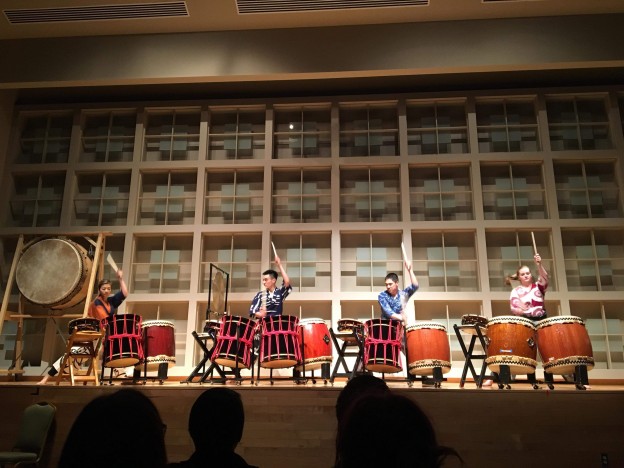
“Growing Stronger” was the theme of this year’s East Coast Taiko Conference (ECTC), which was held at Cornell University from February 22nd to 24th. ECTC chose that theme with the hope to enrich participants’ knowledge of taiko and its community through the opportunity to learn the roots of various taiko styles, to strategize ways to improve group performances, and to build community. This conference has occurred annually since 2011, and this year’s conference saw an attendance reach up to about 200 taiko practitioners (collegiate, amateur, and professional).
A contingent of Swarthmore students from the Taiko Repertory class attended this conference, led by Professor Joe Small. These students are Josie Hung ’19, Hunter Lee ’19, Haruka Ono ’19, Shuang Guan ’19, Kira Emmons ’20, Faye Ma ’20, and Jason Wong ’21. This was the first ECTC for Swarthmore students and Professor Small could not have been more excited to bring his students to this year’s gathering. “I am overjoyed that Swarthmore students made the trip and got involved,” Small said. “Certainly one learns a lot from both theory and practice, but taking part in the community is a whole different way of understanding one’s self while learning about the art.”
Guan can attest to Professor Small’s sentiment that participating within a wider community of taiko practitioners is a very different way to practice and to learn taiko. “At Swarthmore, we learn taiko through preparing for one performance piece for the spring concert,” Guan said. “We don’t really get time to talk about the complexity and diversity of taiko, like its sociocultural/political importance, and what doing taiko looks like outside of Swarthmore. ECTC helped to expose me to some of its multitudes, whether that was the different instruments and playing styles of taiko, the different structures and purposes of other taiko groups, or the diverse peoples that are part of taiko.”
At the final concert of the conference, Professor Small, his colleague Isaku Kageyama, Hung, Emmons, and Wong all performed Small’s original composition called “Propel” as the opening performance. The piece is demanding, requiring stamina and technique, but Professor Small is proud of his three students who were able to excel under the pressure. “The audience’s response was an immediate and thunderous standing ovation,” Small said. “The best remark I heard was that it didn’t seem like ‘three students being pulled along by two professionals,’ but a performance where they carried their own weight and that of others.”
Hung felt deeply honored to have shared the stage with such talented and wonderful people, and she was surprised by the audience’s reception. “I did not expect that an opening performance could get a standing ovation,” Hung said. “But it was extremely rewarding getting a standing ovation as the first act of the night and then having various people come speak to us afterwards about being blown away and really enjoying it.”
All of the Swarthmore student attendees found that ECTC generated discussions among themselves about taiko’s relationship to Asian America. “The conference started some discussions among us Swatties about the nuanced ways taiko interacts with identity formation and empowerment, especially within Asian-America, and we’ve continued to have those discussions back at Swat,” Guan said.
At the same time, ECTC was critiqued for not addressing certain issues. “At ECTC, I found myself debating whether or not there should have been more room for critical conversations of taiko, positionality, and identity within the short span of the weekend,” Hung said. “The question is, considering the dynamics and demographics of the Asian American community now and the need to challenge the centralization of East Asians in conversations of Asian American identity and issues, can the taiko community be more inclusive to the wider Asian American community, and if so how?” Hung further extends this question to ask whether taiko can also be inclusive of non-Asian people of color.
Overall, ECTC has been an eye-opening experience for the Swarthmore students in attendance, with some of the seniors now contemplating joining a taiko group after graduation. The conversations about taiko’s relation to race, class, gender, and colonial history still continue today for these students back on campus, especially since Professor Lei Ouyang Bryant offers a seminar called “Taiko and the Asian American Experience.” In that class, students have an opportunity to develop a greater understanding of taiko within historical, cultural, and artistic contexts. Professor Small hopes that attending ECTC will become an annual tradition for Swarthmore students, and that they continue to take part in the greater taiko community even after college.
David Chan ’19

The semesterly Dance Concerts are opportunities for students participating in Swarthmore’s Dance Program to showcase the work they have been doing over the past semester. This spring’s show will feature ballet, tap, African, and taiko, as well as student-choreographed pieces. Students from all levels and backgrounds of dance participate, forming a collection of individual pieces that, together, reveal the depth and dynamism of Swarthmore dance.
Professor Chandra Moss-Thorne will be showing her newest piece, Plight, at this year’s event. Featuring more than 20 dancers, this contemporary ballet work is set to the music of Italian composer Ludovico Einaudi. Professor LaDeva Davis’s tap dancers will be dancing to music by Aretha Franklin in a piece called Think. The lyrics of the song were written by Ira Tucker Jr. to “accommodate a public service campaign” about the “dangers of driving under the influence.” Professor Saleana Pettaway’s MISS Understandings is set to the music of Rick Allen, Beyonce, the Ibiza Royal Drums, and Me’Shell Ndegeochello. The work is a “tribute to the female experience…It celebrates the power of the female collective and the beauty of our diversity.” Finally, Professor Joe Small’s taiko drummers and dancers will perform a set of arrangements from Japan and beyond. While Soma Bon Uta is a “popular standard at obon across Japan and overseas,” the employment of the ukulele “pays homage to the connection between Japan, Portugal, and Hawaii.” Additionally, Kris Bergstrom’s Jack Bazaar showcases “not the iki of Edo, but Los Angeles.”
The Spring Dance Concert will also feature student works from Zara Williams-Nicholas ’19, Lia D’Alessandro ’21, and Marion Kudla ’19. These pieces allow student choreographers to demonstrate both their technical abilities and their skills in visual composition. Zara Williams-Nicholas’s original work titled Weeping Blue Mahoe, is a piece about identity formation and the “exploration of the self in relation to others.” More than that, Williams-Nicholas says that her dance is reflective of her own experiences here at Swarthmore: In some sense, this work is an “autobiography of [her] journey of finding [herself] at a predominantly white institution.”
Lia D’Alessandro’s piece, Progression, is a contemporary ballet work about the “escape from the traditional image of females in ballet as delicate and dependent upon men.” D’Alessandro says it was inspired by her journey as a ballet dancer “who does not fit the stereotype. It showcases the strength and athleticism of a female dancer in the 21st century.”
Marion Kudla will be presenting her piece titled, Into Interior. Kudla says the work is an extension of a piece she choreographed last fall, called Imprints, which explored the biological concept of rewilding. Rewilding is “an environmental conservation tool that reintroduces ‘native’ species into an environment and lets nature take over to return to an ‘original’ state. Her new piece takes this idea and uses it to explore nature as an “emotional, psychological space.” A work of contemporary ballet, Into Interior “plays on the duality of the word ‘interior’ as both a signifier for nature as well as a personal, reflective process.”
The Spring Dance Concert allows everyone to participate in the incredible diversity of Swarthmore’s performing arts. Faculty works are shown alongside student pieces, and radically different styles occupy the same space. Swarthmore’s dance concerts are a chance for members of the community to experience the hard work of students and faculty, who together reveal the unique kind of joy and catharsis that dance can provide.
The Spring Dance Concert will be held on Friday, May 3rd at 4:30 PM, and Saturday, May 4th at 8:00 PM in the Lang Performing Arts Center. The event is free and open to the public.
Gabriel Hearn-Desautels ’20

In the context of the United States, Kathak dance, a classical North Indian dance tradition, occupies a marginal space within a larger landscape of dance cultures. That is why an event such as New York Kathak Festival has generated much excitement among patrons of Kathak dance. The New York Kathak Festival will be held from April 19th to April 21st, and Professor Pallabi Chakravorty will be bringing her company, Courtyard Dancers, as well as some Swarthmore students to the festival.
The New York Kathak Festival is a newly formed organization that aims to bring together the American Kathak community together for a dynamic and diverse exchange of movements and ideas. “It is the first time that such an inclusive festival is happening in America, although this is not the first Kathak festival happening in this country, since there have been other big Kathak festivals,” Professor Chakravorty said. “But it shows that Kathak is really growing in the diaspora as a dance form among various communities, so you could see that it is very vibrant and something that people want to be part of.”
The organizing of New York Kathak Festival defies the traditionally conceptualized model of cultural sharing; that is, the idea that culture is passed down from the older generation to the younger generation. This time, the younger generation is spearheading the movement to promote Kathak to a wider audience at the cultural center of the United States. “These are young Indian Americans who want to see their culture in this particular landscape of America,” Professor Chakravorty said. “They wanted to include various different choreographers coming from various different traditions within Kathak.”
Being that this festival brings together a diverse group of Kathak practitioners, Professor Chakravorty saw this as a good opportunity to expose Swarthmore students to the Kathak community that spans from the local to the global. “The students will be exposed to an international community of professional Kathak performers and choreographers, so this will be like a cultural immersion, even though the duration will be short,” Professor Chakravorty said. “They will see how India’s diversity of religion, language and costumes are expressed through movement, gestures and sound. Altogether, I am hoping it will be a transformative experience.” All students from the Kathak technique class were invited to attend this festival, and those who signed up will be making the trip soon.
Kathak dance belongs to the North Indian music and dance culture and it is both an Islamic form as well as a Hindu form. “It is a very syncretic dance form, and the dance form itself has a lot of diversity woven into it in terms of identity and aesthetics,” Professor Chakravorty said. In general, Kathak dance is high-energy, featuring a lot of turns and a lot of footwork. Rhythmically, the dance comes from percussion tradition, giving the form that high-energy. Yet, it is the more subtle aspects that Professor Chakravorty is currently interested in exploring: “All of these aspects are exciting, but I have always been interested in the more subtle aspects of Kathak like the subtle breath that goes into the movement, or the subtle hand gesture, or the expressive aspects of the face and how that integrates with a tilt of the torso. These are very fine-tuned things that the dance has so the dance is so strong yet so delicate.”
Courtyard Dancers will perform at New York Kathak Festival on its opening day, April 19th. The company functions as a performing group and as a school to train people in Kathak, with Professor Chakravorty as the company’s Founder and Artistic Director. The company seeks to find the relationship between movement and sound, as well as to create choreographies that explore social issues such as violence between Hindus and Muslims in India, Partition, and the delegitimization of courtesans as dancers to name a few topics. “We are really trying to figure out how to tell stories of modern times using the idiom of tradition since the dance traditionally tells mythological stories or various kinds of spiritual stories,” Professor Chakravorty said.
At the festival, Courtyard Dancers will be performing a piece that they have already showcased elsewhere, called Find Metiabruz. The title of the choreography references a place in Kolkata as well as a glorious history lost by the violent processes of colonialism. “It is a historic place which has completely lost its identity, and through this performance, we try to invoke that particular history so people can know a little bit,” Professor Chakravorty said. “This history relates to the Muslim aspects of Kathak dance, which has been under attack because of Hindu fundamentalism going on in India right now.” Find Metiabruz is accompanied by recorded music, tambourines, and recitations from the dancers.
As of now, the members of Courtyard Dancers are rehearsing as much as they can, since every member has a busy work schedule. They are engineers, doctors, lawyers, bankers, teachers, and students outside of the company, but because each of them want to see the uplifting of Kathak within America’s cultural landscape, they volunteer with much passion. Professor Chakravorty concludes, “The dedication I have from them is stupendous, and we work with very little resources, without grants, or without space. This is truly a labor of love.”
David Chan ’19
Photo by Sasha Fornari
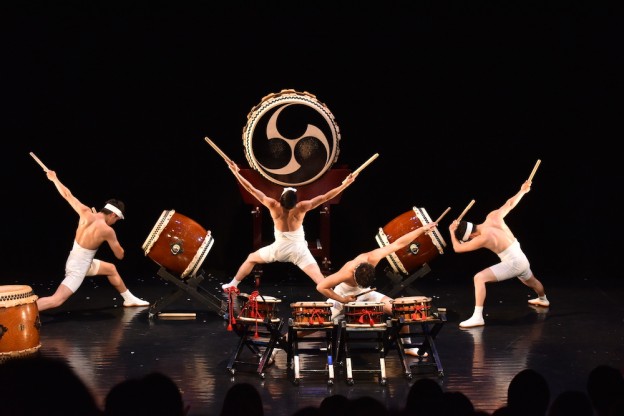
Returning for its annual performance on Monday, April 15th, the Tamagawa Taiko Drum and Dance Group enters the nineteenth year in its close relationship with the Swarthmore Music and Dance Department. Since 2000, the Tamagawa Taiko Drum and Dance Group has garnered annual attention, loyalty, and enthusiasm from Swarthmore faculty and students, as well as members of the surrounding Greater Philadelphia region, with a performance each spring in Philadelphia’s Cherry Blossom Festival.
This close-knit relationship began when retired Professor Kim Arrow of the Swarthmore Dance Program met Tamagawa Taiko director, Isaburoh Hanayagi, at a Philadelphia dance festival in 1999. Since this first serendipitous meeting, Tamagawa Taiko’s presence and influence on students has grown tremendously. Professor Joseph Small, Swarthmore’s new taiko dance professor since Professor Kim Arrow’s retirement, remembers first hearing about Tamagawa University back when he was a student at Swarthmore in 2002. That spring during Tamagawa Taiko’s visit, Small and a few other taiko students learned the piece “Shin-Tamagawa Daiko,” now a mainstay of Swarthmore taiko’s repertory.
“As a member from 2003-2004, along with Alex Hudson ’05, I recall both the physical intensity and vigor of playing, as well as the intricacy of choreography occurring both at the individual level and between the group – sometimes relying upon pinpoint precision, sometimes asking for personal flair and character,” says Small.
It is precisely this vigor and intricacy that Tamagawa Taiko is known for. Small characterizes Tamagawa Taiko’s quintessential and unique style as bright, energetic, and heartfelt, with works consisting of both traditional folk rhythms and wholly new, contemporary choreography. This versatile repertory emerges out of the group’s diverse music and dance training at Tamagawa University. When Small did a semester abroad there, the training involved classes in Japanese folk dance, classical dance known as Nihon Buyo, and the more traditionally Western styles of ballet, contemporary, modern, jazz, tap, and hip-hop.
The students at Tamagawa Taiko however, are not only involved in music and dance training, but also in the production component of their tours and performances. During their first year at University, they are required to work as staff in production and stagework to learn the realities of what goes into a performance. With this kind of investment in their touring, the students in the Tamagawa Taiko group care deeply about what they share with their audiences.
Small hopes that both the students at Swarthmore as well as those in Tamagawa Taiko will have an opportunity to share and exchange culture and passion, taking note of the vast possibilities of taiko and its transnational dimension with Japanese cultural roots. In addition to the formal performance on April 15th in the Lang Music Concert Hall at 7:30pm, there will be a smaller public performance by Swarthmore taiko students – to “drum up interest” – at 12:30pm in front of Parrish Hall.
Marion Kudla ’19
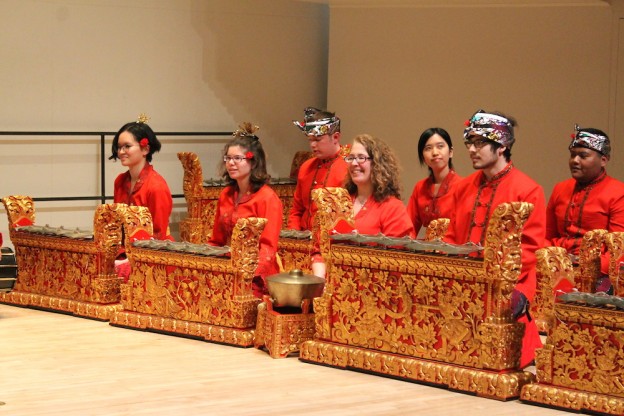
On Sunday, April 14 at 3pm, Gamelan Semara Santi will perform in Lang Concert Hall. The event is free and open to the public.
Gamelan is the traditional ensemble music of Java and Bali in Indonesia, and is made up of primarily percussive instruments. Gamelan does not use notation, and is instead memorized by members of each ensemble. Written music does exist, but only serves to preserve specific pieces. The tempo is controlled by a hand-played drum called kendhang, while other musicians play a variety of traditional Indonesian xylophones, metallophones, flutes, and gongs, as well as several bowed and plucked instruments.
Central to Gamelan music is the idea of collectivity and community; there are no solos, and while musicians do rehearse in individual sessions, emphasis is placed on group participation. Professor Tom Whitman, who co-directs the Gamelan Semara Santi along with I Nyoman Suadin and Ni Luh Kadek Kusuma Dewi, says that community is one of the things that makes Gamelan so special: “I think it creates a real sense of bond that most of us really treasure.” He says that he’s observed something that he, somewhat jokingly, calls “Gamelan ESP:” “If I’ve got four people, and not one of them could play through a pattern by themselves, when they sit down together, they transmit it to each other and somehow they’re able to do it.” Gamelan, he says, allows people to do things in a group that they couldn’t do as individuals.
Gamelan instruments carry immense significance. Most of the keyed instruments are made of bronze which, Professor Whitman says, is considered very spiritually powerful. In Indonesian culture, bronze is said to retain the spirits of every person who has owned it. “I tell them they’re joining a community of people that has been playing the same instruments for more than twenty years. I sort of feel like everyone that’s been a part of it, stays with it.”
Another important aspect of Gamelan music is the dancing that goes along with it. Professor Whitman says that one of the things he likes to tell his students is that, “to do Balinese Gamelan without also doing dance is like performing Beethoven’s 9th Symphony without the chorus – you kind of miss the point.” The upcoming performance will feature both musicians and dancers, all of whom will be dressed in traditional costumes.
Gamelan Semara Santi is made up mostly of Swarthmore students, but other community members have become involved as well. When asked about what one can expect from the upcoming concert, he says:“Beautiful, shimmering, bell-like sounds, great costumes, and a lot of stylistic variety. There’s a tremendously varied musical culture there [in Bali], and every one of the pieces we play sounds remarkable different from all the others.”
Gabriel Hearn-Desautels ’20
| Dance Program Associate in Performance LaDeva Davis, who teaches Tap technique and repertory at Swarthmore, received the 2019 Innovation Award in Dance Development last month at the Mann Center’s “Voices of Hope:” Black History Month Celebration. As a part of the event, the Mann Center honored four iconic educators throughout Philadelphia whose work and determination have greatly impacted the lives of the city’s students. We congratulate LaDeva for her well-earned accomplishment! |
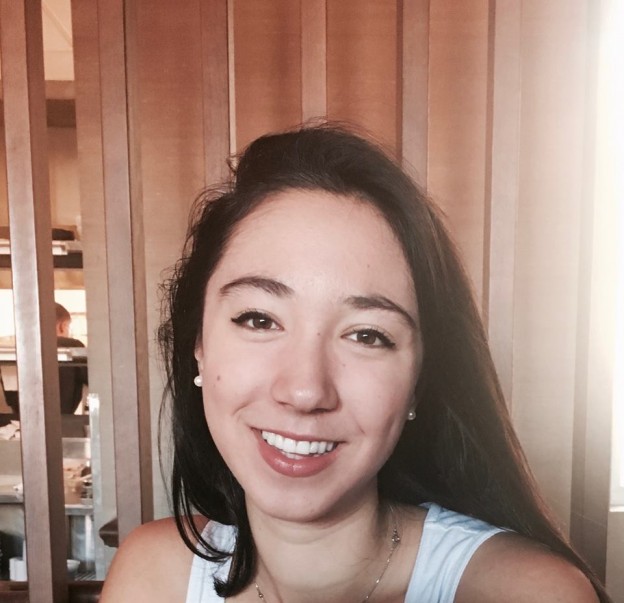
While Swarthmore’s Dance Program is fairly small, it offers students several opportunities to pursue their passions, often by working closely alongside professors. Marion Kudla ‘19, an Honors Dance minor, has taken classes in a variety of styles, from African dance to yoga; participated in performances every semester since her freshman fall; and is currently choreographing her own dance piece as part of her Honors thesis.
“I’ve been dancing since the age of three,” says Kudla. ”I danced ballet at my studio in upstate New York before training at Gelsey Kirkland Academy and Ellison Ballet at age 14 in New York City. I wasn’t expecting to major or minor in dance [at Swarthmore], but I fell in love with the dance [program] here…it’s opened my eyes to a new way of seeing and appreciating dance in a way that I’d never done before.”
The Honors Dance minor requires students to specialize in either Choreography or Dance Studies, culminating in a final project or thesis in senior spring. Kudla has focused specifically on choreography, taking multiple Dance Labs in her time at Swarthmore. She will be presenting her work during the Spring Dance Concert; an outside examiner will ask her about the choreographic process, as well as her previous work. When asked to describe her final project, she explains,
“I’m choreographing a piece that also relates to the environment and finding a ‘wildness’ within, so in that way, my academics have informed by dancing…dance has given me a creative outlet with which to explore ideas and process what I’m experiencing. While physically demanding, dance is also liberating and empowering, and I think having dance alongside academics has been such a wonderful balance at a place as busy as Swarthmore.”
For Kudla as well as other students, choreography proposes a valuable balance between academic work and physical expression. Previously, she has
“…tried to find ways to intersect my academic interests with dance, and last fall (my junior fall), I choreographed a duet that was inspired by ideas of rewilding, a concept I learned about in my conservation biology class. Choreographing has been challenging in…a different way than my other academic courses at Swarthmore. Sometimes you can go into a studio for two hours and not emerge with anything ‘useful,’ but it’s also forced me to let go of my pursuit of perfectionism…encouraging me to open myself up to ideas that are all around all the time.”
At the end of our conversation, Kudla gives a shoutout to the Dance Program, which has consistently supported her in her stage and choreography work. As she puts it,
“It’s an incredible [program] that is small enough to respond to the needs of its students, making each individual grow in the ways that he or she needs. They really foster creativity and exploration in your approach to dance that I think is rare in other departments.”
Emilie Hautemont ’20

On Friday, March 22, Christopher K. Morgan, founder of the dance company Christopher K. Morgan & Artists (CKM&A), will arrive at Swarthmore College to perform Pōhaku, a solo dance theater piece that combines storytelling, hula, modern dance, classical music, and projection design to explore themes of the native people of Hawaii like land loss and fractured identity. Morgan will also take part in a residency on campus where students will have a chance to interact with him, learning about the Native Hawaiian culture including dances like hula.
Pōhaku is Morgan’s first work integrating mele (music) and hula with Western practices, leading him on a far deeper and richer understanding of his multiracial identity than anything he could have ever dreamed. Professor Olivia Sabee of the Dance Program and Professor Alba Newmann Holmes of the English Department found inspiration in Morgan’s experiences as a Native Hawaiian growing up under more Western influences, and wrote a grant to bring CKM&A to campus based on the idea and themes of homeland. This grant aims to bring together students, faculty, guest artists, and staff members to create dialogue and performances that engage with one another’s understanding of homeland.
According to Professor Holmes, “[they] were drawn to the idea of an interdisciplinary collaboration that would invite students, faculty and staff to think about the different ways in which we understand the places of our personal or ancestral origins and how, or if, our sense of homeland connects to our creative as well as our political lives.” Professor Sabee knew of CKM&A and believed that inviting Christopher K. Morgan was “a very natural fit, as his work explores his geographical cultural inheritance from Hawaii, and how he makes that inheritance his own.”
Their hope is that CKM&A will give audience members “the opportunity to reflect on the ways in which embodied experience can be both a means to connect across cultures and a way to create new knowledge.”
Morgan will also hold a modern dance master class on Friday, March 22, at 11:30 a.m. Professor Sabee says she is “excited for students—some of whom already met and/or worked with CKM/A in the fall—to deepen their connections with the company and its artistic staff, to experience what a range of types of work a company might present, in both terms of thematic and movement material, and to think about what it means to tackle serious themes in dance.”
These events are co-sponsored by the President’s Office Andrew W. Mellon Grant, and the performance will take place in the Lang Performing Arts Center on March 22 at 8 p.m.
Maria Consuelo de Dios ’21